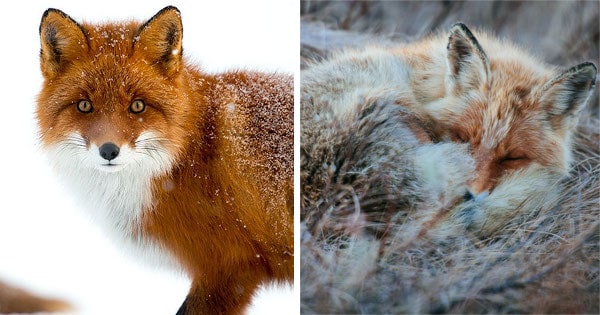Foxes are members of the canine family, which includes dogs, wolves and coyotes. They are about the same size as a small dog or a large cat, but weigh much more than either–up to 9 kg (20 lbs). They tend to look like a cross between a dog and a cat, with pointy ears and long, thick fur that is usually some shade of red.
The fox has whiskers as well as fur on the backs of its legs like dogs do–probably for protection from brush as it hunts. But the similarities stop there.
In terms of physical features, foxes actually have more in common with cats. Like all canines, the fox has a tail. But unlike other dogs, it’s long and tapered like a cat’s tail. Even more telling is the shape of the tail’s base–it twists around in a circle before fanning out.
Foxes also have pointy ears and excellent eyesight, just like a cat. They might even close their eyes half way to protect their vision when they pounce on prey.
Foxes do not hunt in packs like a dog would, but much more like a cat. They will stalk their prey quietly before pouncing on it and eating it whole–prey that can be up to twice the size of the fox itself! Foxes don’t always kill what they eat, either; they might carry an injured animal back to its den before feasting on it later.
Foxes also often hunt at night, which is when cats are most active. They do not have sweat glands like dogs, so they cannot tolerate hot weather. Foxes come out for the summer and change their coats with the seasons just like cats do.
Oh yes–foxes also have a meow-like bark and they purr! They will even rub their faces against other foxes to show affection, just like cats.. And they can be petted and domesticated, though not as easily as a dog. Foxes will even crawl up to humans for food!
Yet, in many places where it lives, the fox is often seen as a pest much like rats and mice. Foxes will raid chicken coops to get food, which has earned them their reputation as poultry thieves. In some areas of the world, including parts of Europe and North America, people even hunt foxes for sport.
Foxes can adapt to a variety of habitats, including forests, grasslands and even cities. Depending on where they live, they might be nocturnal or diurnal, solitary or social. But their independence and elusive nature has earned them another reputation–as tricksters!
In Native American legends from the northeast United States, foxes were known as the “tricksters”. They were clever and mischievous, getting their fellow animals in trouble with humans. Native American hunters would tell stories to their children about the trickster fox.
In Asia, there is a similar story about a fox who took on human form–and found himself a wife! But he couldn’t take his animal form, even when the time came to have children. The villagers were very upset with him, so he ran away into the forest.
The stories about foxes might be part of how people tried to explain these creatures that resembled dogs and cats but acted more like rodents or other pests. They were seen as wild and cunning, perfectly adapted to living in the shadows.
Today, people tend to look at foxes as either cute and cuddly or as pests. But there is still something about these unusual creatures that fascinates us. Maybe it’s because they have dog-like features but act more like cats!

